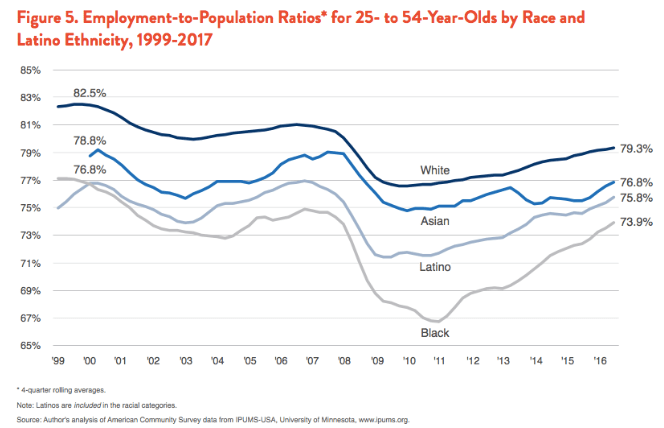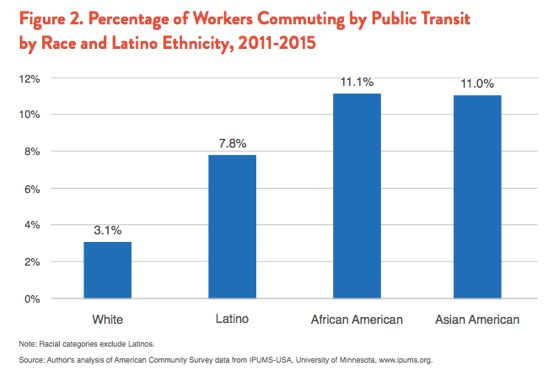Transit Helps Close Minority Jobs Gap
Blacks are three times more dependent on transit to get to jobs than whites.
Despite the decline in the jobless rate, the employment scenario for many Americans isn’t what it used to be. Many people of working age remain without jobs, and the problem is particularly acute for people of color.
Among white Americans between the ages of 25 and 54, about 79 percent are employed. The rate among black, Asian, and Latino Americans remains significantly lower.
Improving transit access to jobs can be a key tool in closing that gap, according a new report from Algernon Austin at Demos, because people of color are more likely than white people to rely on transit to get to work.
The share of Asian and black workers who commute by transit is more than three times higher than the rate among white workers. And for Latino workers the rate is more than twice as high.
This disparity reflects differences in car ownership rates, and it persists across different metro areas. But in some regions, it is even more pronounced. Black workers in Detroit commute via transit at 13 times the rate of white workers (partly explained by the region’s extremely low transit ridership among white workers). In Miami, the ratio is six to one, and in Atlanta, Dallas, and Phoenix it is five to one.
A study by the Public Policy Forum found that 13 percent of workers in the City of Milwaukee do not have access to a personal automobile, compared with 6 percent of workers in Milwaukee County’s suburbs and 4 percent or less in Waukesha, Ozaukee, and Washington counties.
By improving job access for people without cars, Austin argues that transit can reduce racial disparities in employment. To do that, it is crucial that transit investments specifically benefit workers who are sidelined in the current economy.
Similarly, Detroit’s job centers are located throughout the region, but there is no regionally-coordinated transit service. Black transit commuters are twice as likely to spend more than an hour getting to work than white riders. A measure on the ballot in 2o16 that would have funded better regional transit service was narrowly defeated at the polls.
Investment in transit can also help close the racial employment gap through job creation, writes Austin. While black workers are under-represented in construction compared to white and Latino workers, most jobs that result from infrastructure investment are in other occupations. In earlier research for the Economic Policy Institute, Austin concluded that infrastructure spending focused on transit yields the mix of job most favorable to black and Latino workers.
Story by Angie Schmitt with additional contributions from Urban Milwaukee. A version of this story originally ran on Streetsblog. Angie Schmitt is a newspaper reporter-turned planner/advocate who manages the Streetsblog Network from glamorous Cleveland, Ohio. She also writes about urban issues particular to the industrial Midwest at Rustwire.com.
Streetsblog
-
Car Culture Cements Suburban Politics
![Sprawl. Photo by David Shankbone (David Shankbone) [GFDL (http://www.gnu.org/copyleft/fdl.html) or CC-BY-SA-3.0 (http://creativecommons.org/licenses/by-sa/3.0/)], via Wikimedia Commons [ https://commons.wikimedia.org/wiki/File%3ASuburbia_by_David_Shankbone.jpg ]](https://urbanmilwaukee.com/wp-content/uploads/2017/10/1024px-Suburbia_by_David_Shankbone-185x122.jpg) Nov 23rd, 2018 by Angie Schmitt
Nov 23rd, 2018 by Angie Schmitt
-
Most Drivers Don’t Yield to Pedestrians
 Mar 22nd, 2018 by Angie Schmitt
Mar 22nd, 2018 by Angie Schmitt
-
Jobs Up Yet Driving Down in Seattle
 Feb 22nd, 2018 by Angie Schmitt
Feb 22nd, 2018 by Angie Schmitt
Transportation
-
Streetcar Begins Daily Service To The Couture, BRT Will Soon Follow
 Apr 11th, 2024 by Jeramey Jannene
Apr 11th, 2024 by Jeramey Jannene
-
Paper Table Has Plan to Address Double-Parking
 Apr 9th, 2024 by Sophie Bolich
Apr 9th, 2024 by Sophie Bolich
-
Just How Bad Are Milwaukee’s Roads?
 Apr 7th, 2024 by Graham Kilmer
Apr 7th, 2024 by Graham Kilmer


















